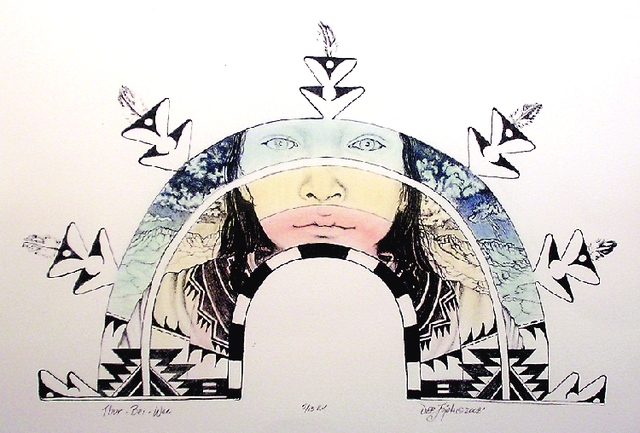The rotunda entrance of the Indian Pueblo Cultural Center fills with a pearly white glow. The sun rays filtering in from the skylights bounce off three bright paper panels attached to sticks with coarse twine hanging from the ceiling. The effect is engulfing, bringing the viewer into a scene literally drawn with sand and adobe brick on the floor below the floating installation. This is the gateway into to Deborah A. Jojola’s visual narrative, Hidden Stories , on display through April 27.The three main panels serve as an introduction (and, in a way, grand finale) for Jojola’s MFA thesis exhibition. Each piece comes together to form a larger-than-life tableta , a Native American women’s headdress, tall enough for someone to stand where the face of the wearer would be. The installations’ pulpy-white papers reflect the sunlight in contrast with the fine, black lines depicting everyday life in near photo-quality lithographic images. The top panel in Jojola’s gateway tableta of two men and two bucks in the back of a truck is flanked by more traditional images of Native women at work, merging the past and present into one frame. The use of the tableta suggests Jojola is not giving her audience a view of what she sees, but what she remembers—telling her stories through paper thought-bubbles.The lithographs in the installation were made from stone carvings on a massive scale, IPCC Museum Director Brian D. Vallo says. Jojola had to use farming equipment to lift the stones, ink them and press them onto the paper. While it isn’t common practice for a printmaker to display her reversed carvings, just knowing about its labor-intensive process makes you want to see the before as well as the after. Hidden Stories includes a number of small-scale prints by Jojola, some black-and-white, some with dry pigment dusted on for hints of color. Jojola included a small version of a print from the main installation, The Hunters—Shu-ta and Shu-oo . As the top panel of the tableta, The Hunters is impossible to inspect due to its height, but along the wall, the viewer can appreciate the meticulous craftsmanship required to develop such a distinguished print.Across the hall hangs a linocut of a tableta , a recurring theme in the exhibit, titled Ceremonious . This is, arguably, the strongest of the small-scale pieces, highlighting the beauty of the fibrous, rice kinwashi paper as well as symmetrical designs inked onto it. Ceremonious capitalizes on the contrast of positive and negative space just as the introductory installation uses white light to cast a dreamlike atmosphere. The result is a sharp, eye-catching print. Hidden Stories is a tiny exhibit with no more than a dozen works on display, but Jojola’s large installation offers enough intricacy to warrant a prolonged gazing. If the rotunda space were bigger, Hidden Stories wound benefit from being presented in a circular fashion with the large installation serving as the beginning and end to allow the audience an initial, uninformed view followed by exploration and then rediscovery. But the Indian Pueblo Cultural Center’s rotunda is a nice location for Jojola’s display, which is the first art exhibit to be displayed outside of the IPCC’s formal gallery spaces. Many more should follow—it would be such a waste of superb lighting not to.
Hidden Stories, Deborah A. Jojola's MFA thesis exhibition, is on display at the Indian Pueblo Cultural Center (2401 12 th Street NW, 843-7270) through April 27. Admission is $6 adults, $5.50 seniors, $4 New Mexico residents and $1 students. For more info, visit /www.indianpueblo.org/[/urlwww.indianpueblo.org.










